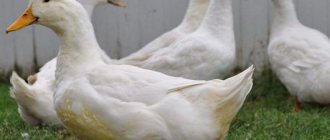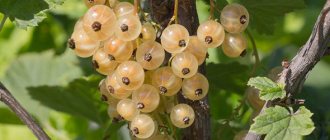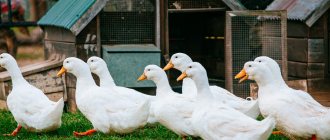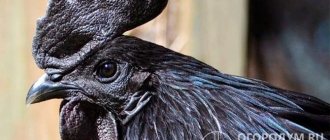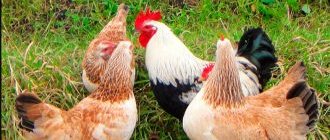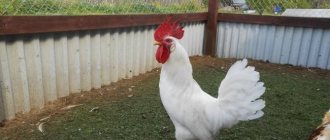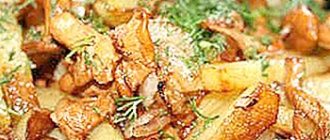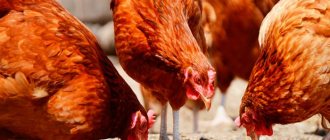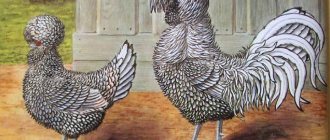Origin
This breed was developed in the 30s of the 19th century. It is based on local chickens of uncertain origin and noble Leghorns.
The breed immediately became a favorite in farmsteads, and in the era of industrial development of the country - in poultry farms. Its absolute popularity lasted until the 90s of the last century. At this time, Leghorns and crosses, which had better egg production rates, began to appear on the Russian poultry market, so the Russian White began to lose ground.
However, breeders are working to improve the characteristics of chickens, achieving competitive qualities. If in previous times laying hens produced up to 190 eggs per year, now it is 200 and even 244, but this cost a loss of egg weight of up to 56 g, as well as a loss of weight of the chicken itself.
Characteristics and standards of Russian White chickens
Representatives of the breed are distinguished by a strong, physique. Features of the body structure can be described as:
- a slender bird with a slightly elongated body;
- the head is medium-sized, proportionally developed, proudly planted;
- strong neck;
- wide chest and stomach;
- the legs and beak are always only yellow;
- legs without feathers, strong;
- white lobes;
- chickens have a small, well-developed tail;
- roosters wear beautiful bushy tails;
- the comb of chickens is not vertical, but leans to the side;
- Roosters have a leaf-shaped comb with five teeth, and the earrings are red.
Adult Russian White roosters weigh up to 2.5 kg, and hens weigh up to 1.8 kg.
An overview of the Russian White chicken breed is presented by the breeder in the video below:
Breed characteristics
Russian White, Ukheyilyuy and Dominant are egg breeds. Despite their small size and light weight, these chickens are very productive, early maturing and hardy. They are distinguished by an active and lively, although somewhat timid, disposition. Laying hens retain egg production well even in the third year of life, which is undoubtedly beneficial for small farms. Read about the description and characteristics of the Australorp chicken breed here.
Appearance
Russian White chickens are distinguished by their stately, proud posture, wide chest, and strong neck.
The body is somewhat elongated upward, the stomach is prominent. Legs are yellow. The tail is wide, short, and in roosters it is quite bushy. The wings are developed, chickens fly well. Puberty of chickens occurs at 5 months, cockerels are even more precocious. The body weight of laying hens reaches 1.6-1.8 kg, and that of roosters up to 2.5 kg. The plumage is pure white, 25% of the chicks also have white down. The crest is large, five-toothed, bright red in adult birds, erect in roosters and hanging to one side in hens. The earlobes are white, which also indicates the white color of the eggshell. The beak is short, strong, yellow.
The egg of a Russian white laying hen always has a white shell and an elongated oval shape. Rounded and colored eggs indicate deviations in the breed.
Advantages and disadvantages
Russian white chickens are distinguished by a number of undoubted advantages, because Soviet breeders worked hard to develop the breed, and work is still underway to select the best representatives of the breed.
This breed has many more advantages than disadvantages.
So, let’s list the valuable qualities of this breed:
- Productivity. Russian white chicken is considered one of the best egg-laying breeds (190-200 eggs per year), inferior in this indicator to Leghorns, laying hens of the Loman Brown and Highsec breeds.
- Duration of the egg-laying period. Chickens lay eggs well at two to three years of age, unlike many egg-laying breeds.
- Unpretentiousness - chickens feel good on the pasture and actively forage even in winter. They consume a small amount of feed compared to meat and egg breeds. Due to their small size, they are suitable for keeping in cages.
- Cold resistance: birds can comfortably tolerate low temperatures, although on frosty days their combs may freeze.
- Strong immunity. Russian white chickens are resistant to many chicken diseases. Chickens are born viable and rarely get sick.
- Tasty, aesthetically pleasing white eggs with strong shells, in demand among customers.
- Beautiful, attractive appearance.
Disadvantages of the Russian White breed:
- Shy character. Many farmers note this as the only drawback of the breed.
- The taste of meat is far from ideal; it is more often assessed by farmers as lean.
Character
Russian White chickens are very active and quickly search for food.
The paddock for this breed must be covered with a net, as the birds tend to fly higher. Bird owners note that noise makes them nervous, and there are cases of mass hysteria. Therefore, it is important to eliminate the noise stress factor near the paddock and chicken coop. It has been observed that melodious, calm music in the chicken coop calms the birds and increases productivity. However, chickens get used to a specific owner and adapt well to the daily routine. Read about the Bress Gali breed of chickens in this material. Chicks are active just like chickens, but they are also shy like adults. It is believed that these chickens show little incubation instinct, although often laying hens still sit on the nest and hatch chicks. Farmers note that if chicks are hatched by Russian White hens, they grow up wild. In this regard, an incubator is recognized as the best option for breeding pedigree chickens.
Cockerels are active at an early age; it is better to keep them separately from the flock. Adult roosters have their claws and spurs dulled, or chickens are blanketed to avoid injury.
Puberty, productivity
The Russian White breed is an early maturing breed. Chickens become adults at 5 months and already begin to produce eggs, roosters even earlier.
Laying hens have a high egg production - 240 eggs per year. They lay eggs for a long time - in the 2nd and 3rd years they practically do not reduce their results, which is rare even among egg-bearing breeds.
Ten hens lay 8-9 eggs per week, each lays 2-3 eggs and then takes a daily break. The eggs are yellowish or white, elongated, their weight is from 50 to 75 g, and they are tastier than those of many breeds.
Cockerels gain weight by six months, it ranges from 1.7 to 2 kg, and at 7 months the weight grows to 2.2 kg. The meat is of average taste, it is considered a bit fresh.
Advantages and disadvantages
The main advantages of the Russian White breed include:
- strong immunity;
- stress resistance;
- rapid puberty;
- high productivity;
- unpretentiousness and adaptation to living conditions;
- good cold tolerance;
- the small weight of the chicken allows you to save on food.
The disadvantages of the breed include:
- the white color of the feather requires cleanliness in the chicken coop and enclosures;
- eggs are not large;
- the taste of meat is not high enough;
- fearfulness and excitability.
Features of maintenance and care
We recommend reading our other articles
- What to feed a horse?
- Pear variety Cathedral
- Honeysuckle jam
- Drip tape
The Russian White breed is unpretentious, but this does not mean that it does not need care.
- The Russian White breed can be kept not only in a chicken coop, on the floor, but also in cages. There should be no more than 6 individuals per square meter of area. Ventilation is provided in the room; the temperature inside throughout the year should be within +16…+25 degrees Celsius. Dampness and drafts are excluded.
- The bedding is made of straw, sawdust or peat. It needs to be changed approximately once every 2 months.
- There is good lighting in the chicken coop, several light bulbs and windows are installed. This will allow you to arrange additional lighting in winter so that the chickens lay eggs better.
You can keep the Russian White breed not only in a chicken coop, on the floor, but also in cages
- The number of drinkers and feeders is calculated based on the number of chickens and roosters. 10 cm of feeder is allocated for one individual. At the same time, only 1 nipple drinker is enough for 8 birds.
- To ensure that birds regularly clean their feathers, you need to place a basin with sand and ash in the chicken coop.
- Walking is mandatory. It is possible to keep birds in cages, but they show the highest productivity with regular walks. The walk is always made spacious so that the birds can run around and stretch their legs. But it is advisable to install a high fence, because the Russian White Hen is capable of flying high.
Important!
The Russian white breed of chickens is immune to Marek's disease, leukemia, and neoplasms.
Since the bird has white plumage, it is necessary to frequently clean the chicken coop, otherwise the chickens and roosters will quickly become dirty and lose their decorative appearance. Cleaning is carried out every 2-3 days so that perches, nests and other surfaces do not have time to become dirty. Feeders and drinking cups are cleaned every day. The premises are disinfected every six months to reduce the risk of parasites and diseases.
Walking is mandatory
Breeding chickens without walking
Chickens of this breed can be kept in battery cages.
If chickens are bred on an industrial scale, cages can be installed in several tiers.
Conditions
The area of the cells is calculated using the formula: 1 sq. m cages for 8 adult chickens.
In this case, you should adhere to the following rules:
- Purity. The cages must always be clean. Carry out cleaning and disinfection in a timely manner.
- Ventilation. An enclosed chicken coop must have sufficient fresh air. Take care of the arrangement of windows or transoms.
- Access to food. Each individual must have unhindered access to food. Install feeders of appropriate length.
- Drinking bowls. There should always be clean water in drinking bowls and free access to it. Refill drinking bowls and keep them clean.
- Temperature. The recommended room temperature is 12-19 °C in winter and up to 24 °C in summer. If necessary, install additional heat sources during cold periods.
- Humidity. Should not exceed 70%. Deviation is allowed by 1-2%. Keep an eye on this indicator, otherwise the bird will start to get sick.
- Illumination. Adjust the lighting - extending daylight hours has a good effect on egg production.
If you violate the rules of keeping, chickens lose productivity and begin to get sick.
Cells
Cages can be purchased ready-made or built independently, following the basic rules.
When making cells, pay attention:
- Frame. Make it from metal or wood.
- Walls. Construct the back and side walls of the cage from fine-mesh mesh, chain-link mesh or plywood. It is better to make the front wall from metal rods so that the bird can stick its head to the feeder.
- Bottom. Make the bottom two-level to make it easier to keep clean. Make the surface on which the chickens will be kept (the floor) from a mesh with small cells so that the bird can stand on it.
- Pallet. Attach a slate, plywood or polycarbonate tray to the bottom, under the mesh floor. Poultry waste products will be collected here.
The tray should be kept clean and thoroughly cleaned every 15-20 days.
- Egg collector. Attach the bottom base at an angle to roll the eggs. At its lowest point, equip a mesh egg collector at a distance of 22-24 cm with open access to remove eggs.
- Feeder. Attach to the front wall of the cage. Should be the entire length of the cage.
- Sources of light. If there are no windows, install point light sources near each cell.
Content
Poultry house requirements
Russian White chickens are raised in cages or a poultry house with a walking area.
The livestock develops normally at a temperature of 14 degrees Celsius, but not higher than 27 degrees. Sub-zero temperatures will cause scallops and earrings to freeze.
To ensure proper use of space, chickens are given multi-level removable perches.
Bunker-type feeders are installed to prevent chickens from raking up the feed. It is convenient to pour grain mixtures or mixed feed into such a container, adding more as needed.
Be sure to monitor the cleanliness of the water in drinking bowls - contamination will lead to an outbreak of intestinal diseases.
Equip a container with an ash-sand mixture so that the birds take dust baths, getting rid of parasites.
Behind a plywood fence they place a nest for every five hens. Wooden boxes with soft bedding made of dry leaves are used as nests.
Litter
It is recommended to keep livestock on thick bedding, reducing food costs.
Chickens, raking the litter, eat insects and weed seeds, looking for protein food. The principle works with a small herd - many laying hens will only compact the litter, not allowing insects to reproduce in sufficient numbers.
Walk or cage batteries
Keeping Russian white breed chickens outside improves their vital activity and prevents rickets. Laying hens look for insects and hide from bad weather under a canopy.
The walking yard is fenced with a high net. Precautionary measures are necessary due to the tendency of Russian White chickens to fly over fences.
When there is a shortage of space, they turn to keeping chickens in cages. This method will help you constantly monitor their condition, making it easier to maintain cleanliness.
Temperature fluctuations negatively affect the livestock, so you will have to strictly monitor the microclimate in the cages.
Signs of shedding
With the onset of autumn, laying hens of the Russian White breed begin molting. Birds lose feathers, lose activity, and look sleepy. A break in egg laying begins.
It is a mistake to treat molting as a disease. After a while, the chickens will resume laying eggs. Installing lighting in the poultry house and adding vitamin and mineral complexes will help chickens moult faster.
Planned herd replacement
Upon reaching 1.5 years of age, egg production in Russian White breed chickens begins to decline. Loss of productivity is easily confused with molting, when the hen regains function after two months.
It is not advisable to keep aged chickens any longer; it is advisable to replace them with young laying hens.
Free-range chicken breeding
Breeding free-range Russian White chickens involves dividing the territory into 2 zones:
- chicken coop where the birds will lay eggs and spend the night;
- poultry yard , where chickens can freely walk and forage.
At the same time, the ratio of areas is observed: 1-2 parts - the area of the chicken coop, 3 - the area of the walking yard.
Breeding free-range chickens is the preferred keeping option. This makes the hens feel more comfortable, which has a positive effect on egg production.
Poultry house
The construction of a poultry house includes the following structures:
- Walls. You can use chipboard, 5-12 mm plywood or boards for construction.
- Insulation. The chicken coop is isolated from external weather factors, wild birds and animals using walls; provide a door in one of them. Seal all cracks and holes in the walls to prevent drafts.
- Canopy and roof. Install a roof over the bird habitat and an awning over the exit to provide shelter during adverse weather conditions.
- Nests. The number of nests depends on the number of chickens. Install them along the walls. Place straw inside.
- Ladder. To ensure that laying hens can easily climb into the nest, install a small ladder or board at least 15 cm wide near each of them.
- Perches. Installed above the floor at a height of about 0.5-0.7 m at the same level or with a gradually rising ladder, so that chickens from the upper roosts do not stain those sitting on the lower ones with droppings. Build them from strong wooden poles with a diameter of 2-3 cm so that the chickens’ paws do not freeze and it is convenient to cling to.
Secure the poles firmly, they should not rotate.
- Litter. Choose a large one, lay it in a thick layer. It needs to be changed often, as the white color of the pen can get dirty.
- Feeders and drinkers. Bring feeders and drinkers into the poultry house for the winter to prevent water and feed from freezing.
Poultry yard
Surround the poultry yard with a high fence - Russian Whites fly well.
When constructing, consider:
- Fencing frame. Build a frame around the walking area from a wooden beam or a solid welded pipe.
- Fencing. Stretch the mesh along the outer sides. The grid cells should be less than 5 cm.
- Laz. Leave a special opening from the chicken coop to the walking yard for free movement of chickens.
- Arrangement of the territory. Make sure that there are no stagnant puddles in the yard and that there are no objects or plants that are dangerous to chickens. You also need to make sure that chickens do not walk where there is a lot of dust.
- Feeders and drinkers. During the warm season, install feeders and drinkers in the walking yard. Cover them with a canopy to prevent rainwater from getting into the feed.
Bird feeding
Chickens of the Russian White breed need to be well fed, and especially from six months to a year, when they begin to lay eggs and productivity develops.
The diet should contain sufficient amounts of:
- Fats. Provides energy. They can be obtained from corn and oats.
- Squirrels. “Building” material for full growth. Most of them are found in legumes, meat and bone meal and bone meal.
- Carbohydrates. Ensure the coordinated functioning of internal organs and metabolic processes. Contained in whole grains.
- Vitamins. Vitamins A, B, D must be supplied. There is a lot of it in fresh vegetables and herbs.
- Minerals. For the formation of egg shells. Contained in additives such as ash and eggshells.
It is advisable to provide the possibility of foraging in open space.
Feeding Russian White chickens is possible according to 2 schemes:
- Purchased ready-made feed:
- compound feed;
- mash;
- vegetables.
- Self-prepared food:
- wet mash of potatoes and vegetables;
- corn;
- fresh vegetables and herbs.
To improve digestion, the bird should have access to containers with sand, pebbles or shell rock.
A laying hen should eat 120-140 g of dry food or 170 g of liquid food per day in 3-4 meals. This mode will allow the chicken not to get fat and produce enough eggs.
Daily feed distribution:
- Morning. It is best to feed whole grains.
- Day. Wet mash, include more mineral and vitamin supplements in the feed.
- Evening. Juicy food, greens.
Table of optimal diet for 1 individual per day:
| Ingredient | Weight, g |
| Corn | 50 |
| Protein feed, mash | 10 |
| Juicy food, greens | 30 |
| Vitamin and mineral supplements | 15 |
| Bone flour | 2 |
Breeding chickens
The breed has a poorly preserved brooding instinct, so they are bred in incubator conditions or eggs are placed under whooping whales of other breeds.
For incubation, it is customary to choose elongated white eggs of at least 60 g. They are stored for no more than 2 weeks in a cool room.
Breeding Russian White chickens in an incubator is no different from other breeds. Read about incubating chicken eggs here.
Russian White chickens are distinguished by their survival rate (94-99%) and health.
Characterized by the following indicators:
- a day after birth, the weight of the chicken reaches 44-46 g;
- downy covering of yellow, sometimes white color without inclusions;
- at 2-3 weeks the sex of the chicks becomes visible - the combs of the cockerels become larger and redder, and the combs of the hens become yellowish-pink;
- during this period, down is gradually replaced by white feather;
- 30-day-old chicks weigh 650 g;
- maximum growth force is observed at 6 months;
- very active from the first days, but shy.
Care
After hatching in the incubator, the chicks are transferred to a cardboard box at the rate of 13-14 chicks per 1 square meter. m.
Proper care:
- Heating. Place a heat lamp above the box and maintain a temperature of 30°C underneath it. Different breeders have different opinions on this matter. Some people prefer to keep the brooder temperature at 28 or 29°C, others find this to be too low.
It is important to heat the space of the box unevenly so that each chicken can be in an area with its optimal temperature.
- Litter. Line the bottom of the box with paper and replace it as needed. After 2 weeks of growth, replace the paper with fabric litter, which has good absorbency. Cotton or wool fabric is suitable, which must be disinfected before use and changed when dirty.
- First walk. After a month, when the body is already stronger and less susceptible to cold, take the chickens outside in good weather. To do this, equip a separate enclosure.
Feeding
Feed chickens according to the following rules:
- Feed newly hatched chickens with boiled, ground eggs with semolina or starter feed. Gradually add greens and cottage cheese. After 1 month of life, introduce vegetables into the diet.
Until 8 weeks of age, chickens are not limited in food. Next, reduce the amount of feed by 20%.
- After 2 months, feed the grown chicks together with the adults. To prepare young chickens for laying eggs, increase the daily protein intake.
- There should be warm water in the box where the chickens are initially kept. Install a drinking bowl and maintain the water temperature in it at the level of the chick's body temperature.
- The dishes from which the chicks eat must always be clean and sterile. To do this, wash it in a soda solution once a day, and then treat it with a 1% solution of potassium permanganate.
The water temperature for chickens should be 30-40 °C.
Chicken diet
In order for birds to develop normally and fully lay eggs, it is recommended to provide proper nutrition. It is selected taking into account age.
Feeding the chickens
Chickens should be fed boiled eggs mixed with cereals and herbs. Chicks also need cottage cheese and yeast. A little later they should be given vegetables. At the age of 1 month, birds can be fed like adults.
Monitoring the cleanliness of drinkers and feeders is of no small importance. It is important to perform preventive disinfection once a day.
Nutrition for adult laying hens
The feeding habits of adult birds depend on the conditions of their keeping. The breed is considered physically active and does not have a tendency to become obese.
However, when grown in cells, metabolic processes deteriorate and productivity decreases. Such birds need less nutritious food.
The daily amount of food should be divided into 3 meals. The average amount of feed is 170 grams. The following components should be present in the diet of chickens:
- concentrates – they account for 40% of the feed;
- compound feed;
- greenery;
- vegetables;
- cereals;
- fish and meat and bone meal;
- yeast;
- flax seeds;
- vitamins and minerals.
Free-range chickens eat pasture. They are allowed to be fed 2 times a day. In winter, the number of meals is increased to 3.
Diseases
This breed is in good health and especially immune to visceral carcinoma, leukemia and neoplastic diseases such as Marek's disease.
But the Russian White is still susceptible to a number of infectious diseases:
- Salmonellosis. It manifests itself as increased thirst and decreased appetite, physical inactivity, and chickens fall on their sides. The stool is liquid and foamy. Sick individuals are isolated and given a solution of Furazolidone (1 tablet per 3 liters of water) for 21 days.
- Colibacillosis. Body temperature rises, which is accompanied by thirst. You can hear wheezing. For treatment, the drug Biomycin is used 0.01 g per 1 kg of bird weight.
- Pasteurellosis . It manifests itself as a lack of movement, increased temperature and thirst, and strong nasal discharge. The stool is loose. Patients are isolated and treated with Tetracycline (1-3% solution) in the amount of 500 mg/day for 3 weeks.
- Newcastle disease. Chickens refuse to eat, have difficulty breathing, and there is noticeable discharge of unpleasant-smelling mucus from their beaks. A few days after symptoms appear, the chickens' comb turns blue and the bird dies. There is no cure for this disease.
- Tuberculosis. Affects any organ of chickens. It manifests itself as lethargy and paleness of the comb and earrings. There is no cure.
After identifying and treating infectious diseases, the chicken coop is disinfected.
In addition to infectious diseases, chickens can suffer from a number of diseases associated with poor nutrition and sanitary conditions:
- Goiter atony. Over time, the goiter hardens and sag. Possible death.
- Gastroenteritis. Appetite decreases, the bird shows lethargy, and stool is loose.
- Cloacite. Inflammation in the cloaca area.
- Avitaminosis. Manifests itself in egg pecking and lethargic behavior.
Non-infectious diseases are treated by improving sanitary conditions and a balanced diet with a high content of vitamins.
Molting and break in egg production
Molting is manifested by the following signs:
- loss of appetite;
- motor lethargy;
- deterioration in appearance;
- break in egg production.
Shedding in chickens is not a disease.
During the molting period, provide the bird with a balanced diet and warmth in the room. After 2 months, the chickens will start laying eggs again.
Planned herd replacement
The Russian White family consists of 10 hens and one male with a spare rooster.
Peculiarities of breed reproduction and frequency of replacement:
- on an industrial scale, laying hens are kept for no more than 2 years, in private farms - up to 3-4 years;
- due to the high activity of roosters, they are kept separately until families are formed;
- from crossing Russian White with Livenskaya Calico, Velzumer, Kuchinskaya, highly productive crosses are obtained;
- The breed requires serious breeding selection; for example, it is not recommended to leave chickens for breeding that are very similar to Leghorns.
You can replenish or update your flock by purchasing hatching eggs or chickens.
Pedigree breeding of Russian Whites is carried out by:
- Maryinskaya poultry farm, Stavropol region;
- poultry farm "Mashuk" in Essentuki;
- CJSC "Adler Poultry Farm" Sochi.
Unpretentious Russian chickens
The beginning of the last century was marked by serious work to develop a new productive breed of laying hens. Breeders set the task of obtaining an egg-laying chicken with high immunity for industrial production.
Since 1920, local outbred chickens have been crossed with Leghorns of English and Danish origin. The resulting livestock were bred among themselves. Next, promising specimens were selected for re-crossing with Leghorns, and again continued breeding within the breed.
At the beginning of its existence, the Russian white breed had two directions - Pyatigorsk and Kuchinsky. Later, the differences between them smoothed out.
In 1953, Russian white chickens were standardized, which made it possible to raise laying hens on an industrial scale in the USSR.
In the following years, Russian White chickens were actively raised in poultry farms. Average productivity reached 200 large eggs per year.
Characteristics of other productive breeds are given in the article “White breeds of laying hens.”
Reviews
★★★★★
Vladimir, 40 years old. My friends and I keep Russian White chickens and are very happy with them.
I am pleased with the number of eggs that chickens lay in the first year of life, as well as their unpretentiousness to living conditions. The main thing is to ensure good nutrition and cleanliness. I never wanted to replace them with another breed. ★★★★★
Ivan, 38 years old. Russian white chicken is very resistant to diseases and has a high survival rate of chickens, unlike foreign breeds.
The number of eggs is simply amazing, and egg production remains at a high level even after 3 years, while foreign breeds need to be renewed every year. Of the minuses, only the taste of the meat can be noted, but there are many more pluses. Hide
Add your review
The farmer has no problems with breeding the Russian White chicken breed. The bird is of the egg type, its productivity remains at a high level for about 3 years. It is not picky about food and living conditions, and tolerates winter well. Among the disadvantages, poultry farmers note only the lost instinct of brooding and the not very good taste of meat.
0
0
Copy link
Similar breeds
A foreign analogue of the Russian White is the Leghorn chicken breed. These are highly productive egg-laying birds. The similarity with the Soviet breed line is visible not only in external characteristics, but also in temperament. Leghorns are inquisitive and active, they love to go for long walks. The average annual egg production of this breed reaches 300 eggs, and hens begin laying eggs at four months of age.
The Russian White chicken breed has earned many positive reviews from poultry farmers. She is unpretentious, has good health and high productivity. Birds are quite friendly; aggression can only manifest itself against a background of stress. In this regard, it is important to provide laying hens with good living conditions and adequate nutrition.
